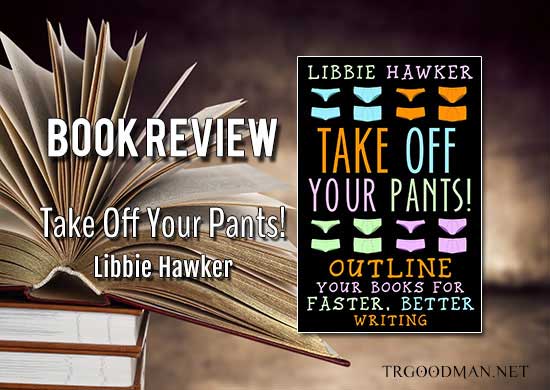Book Review: Take Off Your Pants! by Libbie Hawker
Like many authors, I’ve worked my way through all manner of craft books in an attempt to streamline my process and make it easier to convince a reluctant muse to give up the story for whatever project I happen to be working on. From Million Dollar Outlines to On Writing to Writing the Breakout Novel and beyond, every one of them offered valuable insights on how to proceed, but none of them helped me convince that stubborn muse to loosen her grip. As I discuss in today’s book review, Take Off Your Pants! By Libbie Hawker may have done just that.
By The Power Of Greysk…Tone!
Like On Writing, Take Off Your Pants! speaks to the reader in a conversational tone that lets the education you’re receiving sneak up on you and lodge itself in your grey matter while you feel that you’re receiving an entertaining lecture from a favorite teacher. In fact, by the time you’ve learned about the three-legged outline and the importance of your character’s flaw, you feel ready to launch yourself into the sky, leaving a trail of rainbows and brilliant prose in your wake.
Of course, like any undertrained superhero who doesn’t actually know how to fly, you’re more likely to splat against a wall like Wile E. Coyote than you are to suddenly discover your inner Shakespeare. (Little-known fact: Shakespeare moonlighted as a superhero called The Tempest. No, really, look it up). But if you can keep reading and not rush off to fight crime write your masterpiece, that powerful sense of…um…empowerment…will help get you over that total lack of confidence responsible for word-paralysis among author-kind.
Something Old, Something New, Something Something, Something With Words
As I said a few inches above, I’ve gone through a lot of craft books over the years. If you’ve also read through the entire shelf on writing in the bookstore, there is going to be a lot of familiar ground that you will recognize as you make your way across the landscape of Hawker’s book. But you’ll also come across quite a bit of new snippets of information, golden acorns of writerly goodness that might make you shout, “Eureka!” if you were inclined to do such a thing.
Even though there is quite a bit of similar material as other books, the way Hawker breaks it down and presents it to the reader shaves off the intimidating edges and leaves with you plush, friendly instructions that you can snuggle with while you make up stories of mayhem and destruction. The presentation is excellent, and it brings everything together in a way that’s easy to understand and apply.
You Can Keep Your Pants On (Or Not)
I’m going to risk a brief sojourn into the DMZ between the Republic of Pantsers and the Plotter Kingdom to explain how Hawker addresses the never-ending battle between writers that has raged since two cavemen disagreed about how to tell the others about how they caught that totally awesome caribou they’re dragging back to the cave until they were both eaten by prehistoric wolves. At the risk of betraying my own allegiance to the Plotters, I have to say that Hawker bridged the divide with as much diplomacy as is possible.
While she does focus on a few aspects that she deems critical to a cohesive, successful story (a major flaw, a character arc trying to overcome it, seventeen bottles of wine, etc), she there is no absolute insistence that every little thing needs to be plotted to death ahead of time. Plenty of room is left for writers to enjoy their pants as much as they want. On the other hand, if you prefer to write sans-trousers, she outlines (get it?) a method to get everything down ahead of time so you can breeze through your first draft with all due speed.
Triangles. Lots of Triangles
This method is primarily based on the concept of plot being structured like an inverted triangle, with individual chapters and scenes broken down into smaller triangles that you stuff into the bigger ones like so many slices of literary pie. This is a great way of describing the theory of limiting options and driving the character towards the goal, but I don’t feel that enough time was spent on how to actually accomplish this.
While this doesn’t prevent it from still being an excellent book, it does mean that it’s not the One Outlining Book to rule them all, and you will still need to supplement with other books to get a good grasp on three-act structure, different plot shapes, and how best to lay out your actual plot once you have the story down. It’s not a huge criticism, but it bears noting.
Please, Miss, May I Have Some More?
At just about every step of the way, Hawker provides examples of the device she is describing. Most of these examples focus on Lolita, Charlotte’s Web, and her own book, Tidewater. These examples go a long way toward helping you understand how to apply what she’s talking about, but including a few more would have been very helpful, especially toward the end of the book when she gets into plotting and pacing.
Take Off Your Pants! is by no means the perfect outlining book. It takes a number of familiar concepts and presents them in a friendly, actionable way that empowers the writer and makes you feel like this whole writing thing is easy. While it could use some additional examples and an expanded section on the actual plotting portion, there is something in it for everyone, and it has become by far my favorite book on outlining. Now, if you’ll excuse me, the muse is smiling at me and playing with a cootie catcher. I think she wants to tell me a story.
| |
| |


